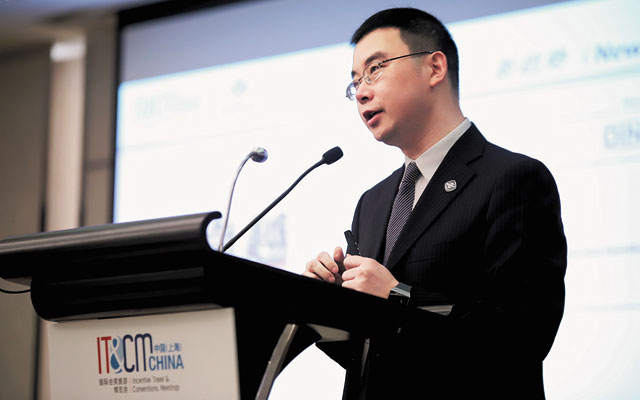Jack Yao, secretary general, China Council for the Promotion of International Trade (CCPIT) Commercial Sub-council and vice president, Chinese Business Event Federation (CBEF), shares how the government and private sector are working together to accelerate development and professionalise the industry.

What are the role, mission and vision of CCPIT Commercial Sub-council in promoting MICE in China?
As the official trade investment and promotion agency authorised by the Chinese government, CCPIT is an important bridge for economic and trade exchange and cooperation among domestic and international businesses.
It is an important force in promoting the development of an open economy and facilitate growth. As one of 23 industry sub-councils set up by CCPIT, the Commercial Sub-council focuses on, for example, the modernisation of services provided, the standardisation of conferences and exhibitions organised, international liaison, training and education.
CCPIT Commercial Sub-council, which plays inbound and outbound roles, is a bridge between international and domestic associations and MICE companies, and uses its international and domestic resources to promote the rapid and orderly development of China’s MICE industry and to build a platform for cooperation and exchange.
When did you assume the role of secretary general of CCPIT Commercial Sub-council and what are your goals in promoting MICE in China?
I have been secretary general of CCPIT since 2016 and my short-term goal is to integrate the resources of the MICE industry to organise activities such as forums, training, competitions and exhibitions in colleges and universities, etc.
The medium-term goal is to upgrade the MICE industry by organising forums, conferences, standardise data research, education and training, and to provide consultation to promote cooperation among government, related institutes and enterprise.
And the long-term goal is to leverage on CBEF to accelerate the sustainable and comprehensive development of China’s MICE industry.
China does not have a convention bureau. Can CCPIT Commercial Sub-council fill this role?
Local convention bureaus have been set up in different provinces and many of them are part of CCPIT local sub-councils, and many play the same role of a local convention bureau. CCPIT Commercial Sub-council, as one of 23 industry sub-councils of CCPIT, belongs to the same system as local sub-councils so we are able to cooperate with each other and streamline business transactions.
How can China create a unified strategy to promote MICE?
The development of China’s MICE industry varies from region to region and local convention bureaus adopt different policies to encourage and support MICE growth. They can jointly promote the development of China’s convention and exhibition industry through cooperation and win-win policies. CCPIT Commercial Sub-council is the channel of communication with these bureaus to realise a win-win effect of what we call “one plus one is greater than two”.
What are the role, mission and vision of the newly formed CBEF?
CBEF is a business event platform founded by the China Chamber of International Commerce Commercial Chamber of Commerce (CCOIC Commercial Chamber of Commerce). Its members include national meeting and exhibition and business incentive associations, influential business event enterprises, research institutes and universities.
Based on its core concept of “promoting China’s economic development via business events”, CBEF fuels the development of enterprise and association meetings, exhibitions and events and MICE business. CBEF aims to promote sustainability and the inclusive development of the industry by promoting enterprise improvement, strengthening national and international exchanges and cooperation among business communities, as well as to foster mutual understanding, sharing of experiences and to deepen cooperation.
As vice president of CBEF, what is your role and what do you want to achieve?
I am responsible for managing CBEF, regularly holding CBEF meetings, integrating resources of all parties and be the bridge between CBEF and its members.
In the short-term, I would like to create special CBEF activities that include the China Congress of Association and Chamber of Commerce, training courses and MICE-related industry standards.
As for the medium-term, I see the need to create a comprehensive transaction and communication platform to provide services such as forums, matchmaking events, industry standardisation, data research, education, training, consulting and so on.
The long-term goal is to set up a MICE industry platform for communication and cooperation between government and society to effectively promote the development of China’s MICE industry.
What are three wishes you have for the MICE industry in China?
I would say they are internationalisation, standardisation and compliance.
Since the Belt and Road Initiative was launched in 2013, China has actively expanded cooperation with countries along the Belt and Road and is committed to promoting globalisation. China’s MICE industry also needs to keep pace. We need to promote the MICE industry internationally, actively introduce international conferences to China and encourage related enterprises to venture out, increasing the international visibility of China’s MICE institutions and enterprises.
There is a saying that “third-rate enterprises make products, second-rate enterprises make brands and top enterprises make standards”, so standardisation plays a vital role in the development of enterprises and industries and help China’s MICE companies be on par with their international counterparts.
Advocating and encouraging MICE companies to establish a compliance management system is key to the healthy, stable and sustainable development of the entire industry.





















